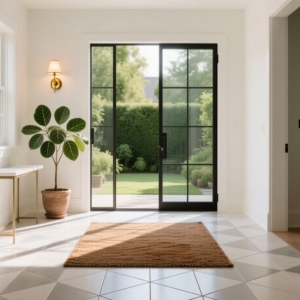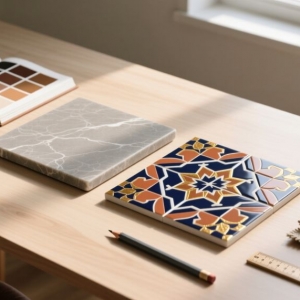Stepping into a ceramic tile shop to choose kitchen flooring can feel like diving into a sea of options. The variety of sizes, finishes, colors, and technical specs can be daunting. A wrong choice can become a daily nuisance, while the right one enhances your kitchen’s functionality and charm. This guide offers clear, practical advice to help you navigate the process.
Focus on Function First
Kitchens are tough environments, facing spills, dropped pots, and heavy foot traffic. Your floor must withstand moisture, wear, and frequent cleaning. Prioritize durability and slip resistance before aesthetics. By understanding your kitchen’s demands, you can select tiles that perform reliably while complementing the space’s style.
Porcelain vs. Ceramic: The Main Decision
Both ceramic and porcelain tiles are made from clay, but porcelain is denser, less porous, and more resistant to stains and scratches. For most kitchens, porcelain is the preferred choice due to its toughness. Ceramic works in less demanding spaces or when budget is tight. When visiting a ceramic tile shop, ask about PEI ratings, which indicate surface durability and guide your selection.
Tile Size and Room Dynamics
Tile size shapes how your kitchen feels. Large-format tiles create a spacious, open look, ideal for compact kitchens. Smaller tiles add visual texture and can hide minor subfloor imperfections. In a narrow kitchen, rectangular tiles laid lengthwise elongate the space visually. If your subfloor is uneven, smaller tiles are easier to install smoothly.
Finish: Safety Meets Style
Glossy tiles reflect light and look polished but show smudges and can be slippery when wet. Matte or textured finishes offer better traction and conceal dirt. For kitchens, choose tiles with a high slip-resistance rating (COF). A slightly textured porcelain tile balances safety with easy maintenance, making it ideal for busy spaces.
Color and Pattern: Mood and Upkeep
Color influences the kitchen’s atmosphere and maintenance needs. Light tiles brighten small spaces but reveal spills. Dark tiles hide dirt but show dust or scratches. Mid-tones like warm beige or soft slate are practical and timeless. Patterned tiles add personality but may date faster. Use bold designs sparingly, such as in a corner, to keep the look versatile.
Grout: A Small Detail with Big Impact
Grout color and joint width define the floor’s appearance. Contrasting grout emphasizes tile edges, while matching grout creates a seamless surface. Narrow joints with rectified tiles give a modern vibe. In kitchens, opt for stain- and mold-resistant grout, like epoxy, which is costlier but easier to clean and more durable in wet, greasy conditions.
Tiles and Underfloor Heating
Tiles are perfect for underfloor heating. Porcelain conducts heat efficiently and remains stable through temperature changes. Large tiles work well but require a flat subfloor and skilled installation. Consult your contractor and the ceramic tile shop about adhesives and expansion joints to ensure compatibility.
Durability Metrics to Know
Check PEI (abrasion resistance), COF (slip resistance), and water absorption ratings. For high-traffic kitchens, aim for PEI 3 or higher. Ceramic tile shops typically provide technical data sheets—request them. These concise documents help you choose tiles that meet your kitchen’s needs.
Installation: The Key to Longevity
Even premium tiles fail with poor installation. Proper subfloor prep, leveling, adhesive choice, and joint spacing are critical for durability. Hire a tiler with kitchen experience and review their past work. A skilled installer will guide you on transitions to other flooring and necessary expansion joints.
Maintenance and Total Cost
Consider upkeep when selecting tiles. Porcelain is low-maintenance, needing only regular sweeping and mopping. Natural stone requires periodic sealing. Epoxy grout resists stains but is harder to replace if needed. Factor in cleaning time and products alongside tile cost to assess the full investment.
Coordinating with Kitchen Elements
Tiles should complement your cabinets, countertops, and walls. Bring samples of these materials to the ceramic tile shop and test them under different lighting. A tile that pairs well with warm wood might clash with cool quartz. Subtle mismatches can be noticeable in person, even if they seem minor in photos.
Budgeting Strategically
Your budget covers tiles, installation, subfloor prep, grout, and trims. Cheap tiles may save money upfront but cost more if they wear out quickly. Prioritize durable floor tiles, even if it means choosing more affordable wall tiles later. Quality installation is as crucial as the tile itself.
Sustainability and Health Considerations
If eco-friendliness matters, ask the ceramic tile shop about recycled content or low-VOC manufacturing. Porcelain’s high-energy production is offset by its longevity, reducing waste. Choose low-VOC sealants and grouts to minimize indoor air pollution, especially in a kitchen prone to grease and moisture.
Before You Commit
Take tile samples home. Test them in your kitchen’s natural and artificial light. Walk on them to check comfort. See how they pair with cabinets and counters. If you’re unsure, wait a day. A kitchen floor is a long-term choice, and a brief pause can ensure confidence.
Final Thoughts
The ideal kitchen tile blends durability, safety, and style. Start with function, select a material suited to kitchen demands, and choose colors and finishes that align with your lifestyle. Explore options at a ceramic tile shop, review technical specs, and hire a skilled installer. With these steps, your kitchen floor will perform reliably and enhance your space for years.











